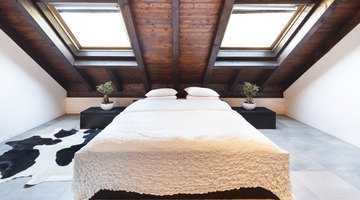How to Prevent Skylights From Condensation Drip
A skylight has the ability to transform a drab, unwelcoming atmosphere into one that feels warm and inviting -- unless it develops condensation and drips. Where there is water buildup, there is bound to be a leak. Don't lose heart.

As long as your skylight is in good shape and has been installed properly, chances are that you can easily prevent skylight condensation from marring your view.
Things You Will Need
- Skylight owner's manual
- Flat-head screwdriver
- Phillips screwdriver
- Silicone caulk
- Gloves
- Plastic bag
- Old rags or paper towels
Tip
Try not to become frustrated if you must make repeated attempts to prevent your skylight from leaking. Unfortunately, the best time to spot a leak is when it's raining, which is no time at all to be climbing on top of your roof. Even roofing professionals find skylights to be challenging. Unless you are a licensed roofer, leave more complicated repairs, such as holes or damage around the skylight, to an expert. Skylights usually leak because of a fundamental problem with construction or installation, or because of a buildup of debris.
-
Gain access to the roof -- the only way to do this job -- and inspect the skylight and the area around it. Focus on the skylight corners and joints. If you see a crack or hole, cover it amply with silicone caulk.
-
Open the cap of the skylight to expose the flashing, which fits around the perimeter of the skylight to effectively seal it and keep moisture on the roof, where it belongs. Scoop up any dirt, leaves, branches or other debris, which can settle around the skylight hole and unwittingly create a dam that causes condensation and water to pool and drip indoors. Buildup is the most common cause of skylight drips. Be careful not to drop debris into your home. Wipe the flashing with a clean rag.
-
Check the weather stripping around the skylight. If it is damaged or torn, replace it. Check the underlayment, which wraps around the skylight to guard it against the elements. If it looks damaged, call a roofing specialist or the installer to replace it.
-
Gain the upper hand on excess moisture in your home, which is causing the condensation in the first place. Ensure that the room is properly ventilated and that air circulates freely. For example, open windows when you can and run exhaust fans.
-
Perform preventive maintenance on your skylight at least once a year -- more often if you live in a heavily wooded area.
The Drip Cap
- A skylight has the ability to transform a drab, unwelcoming atmosphere into one that feels warm and inviting -- unless it develops condensation and drips.
- Focus on the skylight corners and joints.
- Open the cap of the skylight to expose the flashing, which fits around the perimeter of the skylight to effectively seal it and keep moisture on the roof, where it belongs.
- If it looks damaged, call a roofing specialist or the installer to replace it.
References
Writer Bio
With education, health care and small business marketing as her core interests, M.T. Wroblewski has penned pieces for Woman's Day, Family Circle, Ladies Home Journal and many newspapers and magazines. She holds a master's degree in journalism from Northern Illinois University.
Photo Credits
- piovesempre/iStock/Getty Images
- piovesempre/iStock/Getty Images
More Articles



